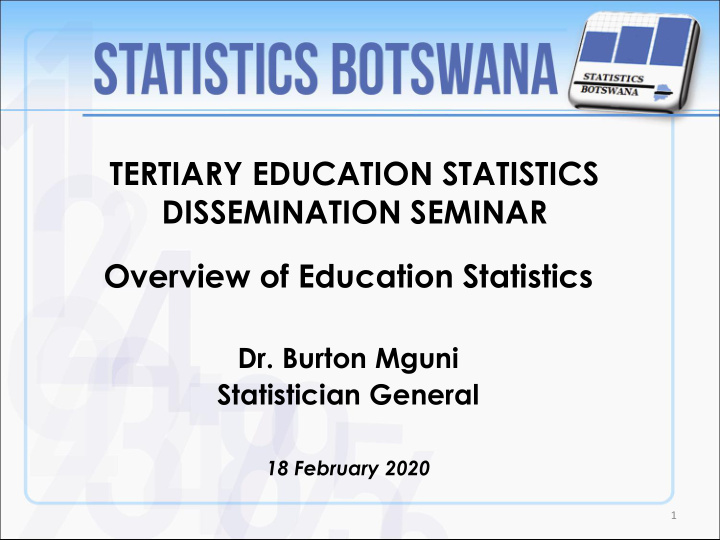



TERTIARY EDUCATION STATISTICS DISSEMINATION SEMINAR Overview of Education Statistics Dr. Burton Mguni Statistician General 18 February 2020 1
Outline 1. Production Of Tertiary Education Statistics 2. Level of Performance on Quality Dimensions 3. Status on Provision of Data for Development Agendas 2
Production of Tertiary Education Statistics Context: Education Sector of the National Statistical • System Institutions produce primary data • Pre- HRDC - Produced by CSO on basis of Data from • Ministry HRDC in Collaboration with SB • Collection , Processing summarization & analysis by HRDC Quality Assurance by SB 3
Dimensions of Data Quality The Data Quality Assurance Framework (DQAF) is used • internationally for evaluating and certifying statistics produced a given entity as meeting the required standards. The Botswana DQAF was approved by SB Board in Dec • 2019 for implementation across products from the NSS. DQAF has 8 Dimensions of Data Quality • 1. Credibility - values and related practices that maintains users’ confidence in the agency producing statistics 2. Relevance - degree to which the statistical product meets the needs of users. 3. Accuracy - degree to which the product correctly describes and or estimates the phenomena it was designed to measure. 4
4. Methodological Soundness - application of international, regional and national standards, guidelines, and good practices 5. Timeliness an Punctuality - time lag between the reference point to which the information pertains and the date on which the information becomes available; time difference between the date the data are released and the target date on which they were scheduled for release 6. Comparability & Coherence - ability to compare statistics ; the degree to which it can be successfully brought together with other similar statistical information from different sources 5
7.Accessibility - ease with which the statistical information can be obtained from the agency 8. Interpretability - ease with which users understand statistical information through the provision of supplementary information (metadata and relevant supporting documents). 6
Level of Performance on Quality Dimensions Credibility - Still to be confirmed with more yearly reports produced Relevance – produced data ; enrolment; transition graduation; ratio have adequate coverage of user needs Accuracy - good Methodological Soundness – international standards and guidelines met; Timeliness an Punctuality – yearly periodicity is acceptable practice; need to aim for a dashboard to have real time and yearly summaries 7
Comparability & Coherence – cross institutions; programme and international comparisons possible Accessibility – website Interpretability – data collection process outlined; metadata on ratios provided 8
Status on Provision of Data for the Development Agendas 1. AGENDA 2030 SDGs; Global 2. Agenda 2063 ; Continental 3. Vision 2063 ; National 4. NDP 11 9
Education-related targets and indicators for the SDGs 10
SDGs Goal Specific to Education is Goal 4 Tertiary Focused Targets and Indicators Target 4.3 By 2030, ensure equal access for all women and men to affordable and quality technical, vocational and tertiary education, including university 4.3.1 Participation rate of youth and adults in formal and non-formal education and training in the previous 12 months, by sex No Data Target 4.5 By 2030, eliminate gender disparities in education and ensure equal access to all levels of education and vocational training for the vulnerable, including persons with disabilities, indigenous peoples and children in vulnerable situations 11
4.5.1 Parity indices (female/male, rural/urban, bottom/top wealth quintile and others such as disability status, indigenous peoples and conflict- affected, as data become available) for all education indicators on this list that can be disaggregated - No Data 12
Agenda 2063 ASPIRATION 1: A PROSPEROUS AFRICA BASED ON INCLUSIVE GROWTH AND SUSTAINABLE DEVELOPMENT GOAL 2 : WELL EDUCATED CITIZENS AND SKILLS REVOLUTION UNDERPINNED BY SCIENCE, TECHNOLOGY AND INNOVATION EDUCATION INDICATORS ARE AT PRE-PRIMARY, PRIMARY AND SECONDARY LEVELS 13
Table 1: Education Sector NDP11 KPIs Vision 2036 Transitioning to a high income economy with export led growth underpinned by high levels of productivity, diversified economy, inclusive and Objective sustainable growth Key Result Area Key Performance Unit of Data Source Reporting Baseline Targets Relevant programmes Indicator measure Frequency (Year) contributing to and 2017/18 2018/19 2022/23 informing targets Sustainable, % of Higher Percentage BQA - Annually 75% 75% 78% 90% NCQF; Quality Inclusive and Education Accreditation (2016) Assurance; Basic Competitive Programmes that Reports Education Programme Economy meet national (Infrastructure accreditation Development and standards Teacher Capacity Building) Tertiary Graduation Percentage HRDC - Annually 82% 82% 84% 90% Skills Development Rate Tertiary (2015/16) Programme; Human Education Resource Planning Statistics and Management Report Programme; Human Resource Development Strategy Proportion of Percentage HRDC - Tertiary Annually 63% 65% 70% 80% Skills Development undergraduates Education (2015/16) Programme; Human enrolled in priority Statistics Resource Planning skill areas Report and Management Programme; Human Resource Development Strategy 14
VISION 2036 Data available for some indicators but indicators not computed 15
NDP11 PERFORMACE INDICATOR FRAMEWORK Data available for some indicators but indicators not computed 16
Global SDG 4 Statistics (UIS Website) • Sustainable Development Education Data Digest • eAtlas for Education 2020 17
Enrolment rates, Completion rate, Dropout rate, Transition rate (%) 120 98.70 100 93.70 80 69.80 % 60 40 20 2.01 0 2013 Enrolment rates Completion rate Dropout rate Transition rate Source: Sustainable Development Goals of Botswana, 2018
THANK YOU 19
Recommend
More recommend